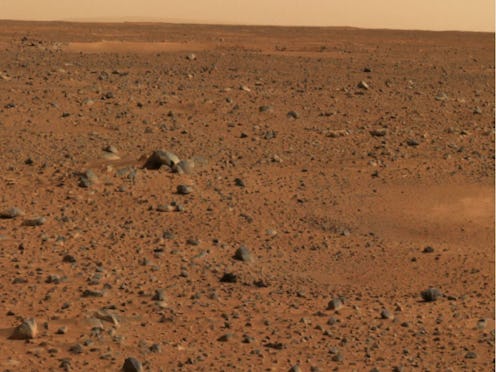News
NASA's Mars Rover Made A Big Find
I'll confess right at the top — I'm about as geeky about martian exploration as anything, and with each new discovery brought back to us by the NASA Curiosity rover, my heart sings a little. There's something incredibly exhilarating, humbling and inspiring about knowing just how far our scientific achievement and ambitions can take us, and in this case, that's all the way to the surface of Mars. On Wednesday, all that collective effort turned up an exciting revelation — the NASA rover Curiosity found new fluid evidence in the Red Planet's past, by way of some "two-toned" mineral veins.
In short, this is a discovery that should allow researchers to learn more than ever before about the history of fluids on the Martian surface. As detailed by NASA's Jet Propulsion Laboratory blog, here's the basic idea: Curiosity has been analyzing rock samples from different layers of the martian mountain Aeolis Mons, also known as "Mt. Sharp," and in doing so it made a startling discovery: veins of light minerals bordered by partially-eroded dark ones, discovered inside the rock of a basin once home to a lake. The light and dark coloration, according to the NASA report, suggests that fluid was moving inside the rock after the basin had otherwise dried up, further suggesting that Mars possesses the potential to host microbial life.
And of course, when you're roaming the surface of a strange, foreign world, nothing's quite as exciting as finding signs of any kind of life being able to thrive. Linda Kah, a member of the Curiosity team with the University of Tennessee, Knoxville, describes the mineral veins as looking "like ice cream sandwiches" in the report, and that's an evocative description — who hasn't eaten one of those things at some point? Kah described Curiosity's exciting find to the Los Angeles Times:
Not only does this help us try to understand the chemistry of the rocks that we measure in the region, but on a different sort of scale it tells us that fluids were around on Mars for a long time.
To put it simply, this is just one more step in the long process of unraveling Mars' mysteries. But we've had a lot of these kinds of stories lately, thanks to the noble little Curiosity. Since it launched back in November 2011, and finished its long voyage to Mars in August 2012, it's provided us with a tremendous amount of new insight into Mars' habitability. Here's hoping it uncovers a lot more while it has the time — while it's fueled by nuclear power, it'll eventually run out of juice at some point in the next few years.
Image: Getty Images
